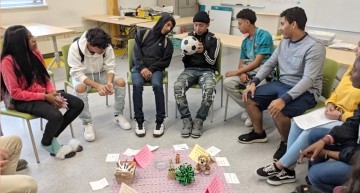Many schools use exclusionary discipline—such as suspensions and expulsions—with the intention of reducing misbehavior and improving school safety. However, research shows that the use of exclusionary discipline ultimately increases misbehavior, undermines school climate, reduces achievement, and increases dropout and incarceration rates. In addition, long-standing research documents the disproportionate use of punitive discipline practices for students of color and students with disabilities. As an alternative, many schools have sought to replace harsh disciplinary policies with restorative practices.
What Are Restorative Practices?
Restorative practices are designed to build a strong sense of community in schools, to teach interpersonal skills, to repair harm when conflict occurs, and to proactively meet students’ needs—including those that result from trauma in or outside of school—so misbehavior is less common. Instead of punishment, restorative practices address school discipline by focusing on developing communication strategies and building relationships. Among restorative practices are classroom meetings, community building circles, and conflict resolution strategies that all adults and students use. Additionally, restorative practices include mediation strategies that can be used to resolve disagreements, help students make amends, and support students’ reentry to the school community after a challenge has occurred.
What Are the Impacts of Restorative Practices?
A growing body of research indicates that well-implemented restorative practices:
- improve student behavior
- decrease fighting and bullying
- reduce office referrals and classroom removals
- reduce suspensions and expulsions
- decrease disciplinary disparities
- improve school climate, including relationships between students and teachers and student feelings of connectedness to school
A recent study of a large-scale data set in California found that the more students experienced restorative practices, the more student behavior, student mental health, and disciplinary outcomes improved. Additionally, the study found that exposure to restorative practices improved school safety and academic outcomes for all groups of students, with stronger effects for Black and Latino/a students, suggesting that the use of restorative practices can reduce achievement gaps.
What Does It Take to Implement Restorative Approaches?
The work of integrating restorative approaches into school settings is complex and requires both policy and practice supports. Studies suggest the importance of the following:
- replacing zero-tolerance and punitive discipline policies with school designs and discipline approaches that strengthen relationships
- incorporating indicators of exclusion, restorative practices, and school climate in state and local continuous improvement and accountability systems
- utilizing a whole school approach that integrates community-building strategies, interpersonal and conflict resolution skills, and restorative responses to disciplinary incidents
- providing long-term investment in whole school learning opportunities that increase staff buy-in and skill in implementing restorative practices
- centering student and community voices so that all students experience restorative practices in a manner that deepens their connection to the school
This fact sheet is based on: Darling-Hammond, S. (2023). Fostering belonging, transforming schools: The impact of restorative practices. Learning Policy Institute.; Klevan, S. (2021). Building a positive school climate through restorative practices. Learning Policy Institute.
Restorative Practices: How Schools Can Improve Safety, Behavior, and Student Achievement (fact sheet) is is licensed under a Creative Commons Attribution-NonCommercial 4.0 International License.
Core operating support for the Learning Policy Institute is provided by the Heising-Simons Foundation, William and Flora Hewlett Foundation, Raikes Foundation, Sandler Foundation, and MacKenzie Scott.
Photo credit: Tatiana Chaterji, Fremont High School
